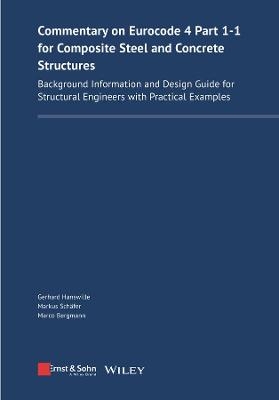
Commentary on Eurocode 4 Part 1-1 for Composite Steel and Concrete Structures
Wilhelm Ernst & Sohn Verlag fur Architektur und technische Wissenschaften
978-3-433-03339-5 (ISBN)
- Noch nicht erschienen (ca. Februar 2025)
- Versandkostenfrei innerhalb Deutschlands
- Auch auf Rechnung
- Verfügbarkeit in der Filiale vor Ort prüfen
- Artikel merken
In addition, an insight is given into the current state of discussion in the development of the regulations for the next generation of Eurocode 4 and important, expected changes and additions are pointed out.
Prof. Dr.-Ing. Gerhard Hanswille is a partner at HRA Ingenieurgesellschaft in Bochum and a checking engineer for structural design. Up until 2017 he was the managing director of the Institute of Structural Engineering at the University of Wuppertal and professor for steel and composite structures. He is a member of the North Rhine-Westphalia Academy of Sciences and was chair of the DIN working committee for composite construction from 1993 to 2018, also a member of the DIN EN 1994-1-1 and DIN EN 1994-2 project teams during that time. This publication benefits from his experience gained with several advisory bodies and DIN working committees, the German Institute of Building Technology (DIBt), the Federal Railway Authority (EBA) and the Federal Ministry of Transport and Digital Infrastructure (BMVI). Main fields of work: Research studies in the field of steel-concrete composite construction with a focus on composite technology, life cycle analyses and structural stability. Besides projects involving buildings and industrial structures, in recent years he was active as a structural and checking engineer for larger steel and composite bridge projects. Prof. Dr.-Ing. Markus Schäfer was appointed Full Professor of Structural Engineering and Composite Structures at the University of Luxembourg (Department of Engineering) in 2017. The period between gaining his doctorate in steel and composite construction at the University of Wuppertal in 2007 and his professorial appointment was filled with international engineering activities as technical director of Spannverbund S. A., as Directeur des Etudes at CLE S. A. and teaching activities as a university lecturer. He is currently deputy chair of the DIN Eurocode 4 mirror committee and a member of CEN/TC250/SC4 and other national and European working groups for composite construction. As part of the EU mandate M/515, he is also currently involved with drafting the second generation of EN 1994-1-1 as leader of the CEN/TC250/SC4.T6 project team. Main fields of work: Research studies in the field of steel-concrete composite construction with a focus on composite/slim-floor beams, shear connectors, composite columns and the use of high-strength materials. In addition, he is heavily involved in standards development. In recent years he participated in the design and construction of many steel and composite structures. Dr.-Ing. Marco Bergmann is an engineer at HRA Ingenieurgesellschaft in Bochum. He gained his doctorate in the structural fire design of composite columns at the University of Wuppertal in 2011. He has been a member of the DIN working committee for composite construction since 2015 and for many years has served as a lecturer for the Real Estate Management and Construction Project Management (REM + CPM) course of study at the University of Wuppertal. Main fields of work: Research studies in the field of steel-concrete composite construction with a focus on composite columns and shear connectors. In recent years he was involved in checking larger steel and composite bridges and the design of composite buildings.
Preface
1 General
1.1 Introduction to and scope of EN 1994-1-1/DIN EN 1994-1-1
1.2 Normative references, NADs and NDPs
1.3 Assumptions
1.4 Distinction between principles and application rules
1.5 Notation, terms and definitions
1.6 Documentation
2 Principles of structural design ¿ safety concept
2.1 General
2.2 Principles of limit state design
2.3 Basic variables
2.4 Structural analyses with partial safety factors
2.4.1 Design values
2.4.2 Ultimate limit states ¿ combination rules
2.4.3 Serviceability limit states ¿ combination rules
3 Materials
3.1 Concrete
3.2 Reinforcing steel
3.3 Structural steel
3.4 Fasteners and shear connectors
4 Durability
4.1 General
4.2 Profiled steel sheeting for composite slabs in buildings
4.3 Durability criteria for steel components
4.4 Durability criteria for conventionally reinforced concrete members
5 Structural analysis
5.1 Structural modelling for the analysis
5.2 Global structural analysis
5.3 Imperfections
5.4 Calculation of internal forces
5.5 Classification of cross-sections
6 Analyses for the ultimate limit states
6.1 Composite beams
6.2 Cross-section resistance of composite beams
6.3 Cross-section resistance of composite beams with encased webs
6.4 Lateral-torsional buckling of composite beams
6.5 Transverse forces on webs
6.6 Shear connections for composite beams
6.7 Composite columns
6.8 Verification for fatigue
7 Analyses for the serviceability limit states
7.1 General
7.2 Internal forces and stresses
7.3 Deformation limits and vibration behaviour
7.4 Deformation limits and vibration behaviour
7.5 Deformation limits and vibration behaviour
8 Composite joints
8.1 General
8.2 Calculations, modelling and classification
8.3 Method of analysis
8.4 Resistance of basic components
8.5 Rotation capacity and outlook
9 Composite slabs
9.1 Principles and definitions
9.2 Design principles
9.3 Actions and their effects
9.4 Calculation of internal forces
9.5 Analyses required for the profiled steel sheeting for the construction state ? ultimate limit state
9.6 Analyses required for the profiled steel sheeting for the construction state ? serviceability limit state
9.7 Analyses for the final state ? ultimate limit states
9.8 Analyses for the serviceability limit states
References
| Erscheinungsdatum | 17.11.2022 |
|---|---|
| Verlagsort | Berlin |
| Sprache | englisch |
| Maße | 170 x 244 mm |
| Themenwelt | Technik ► Bauwesen |
| ISBN-10 | 3-433-03339-0 / 3433033390 |
| ISBN-13 | 978-3-433-03339-5 / 9783433033395 |
| Zustand | Neuware |
| Haben Sie eine Frage zum Produkt? |
aus dem Bereich


